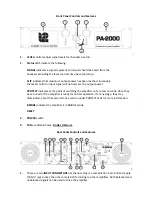
13.
A.C. POWER
inlet.
14.
FAN VENTILATION HOLES
. Do not obstruct. It is advisable to try and keep a 1U space above
and below the amplifier if it is in a flight case.
Operation
Decide the required mode for the amplifier and select the appropriate rear panel switches.
Always ensure that all signal and power connections to the amplifier are properly made before
switching on. It is advised to make sure that the level controls are set to minimum. Any amplifier
(s) in a system should always be switched on last (with volume down) and switched off first (with
volume down) to prevent any pop or noise originating from other equipment.
Make sure that the speakers being used have the correct power rating for the amplifier. This will
help avoid possible damage to the speakers.
Always use the LIMITER (rear panel switch in the out position) as it helps prevent distortion on
large signal peaks.
Use the 35Hz filter (rear panel switch 'in' position) as it will improve the bass power handling and
clarity of the system. This is especially important with vented / ported / 'bass reflex' cabinets.
When used with a pro-audio mixer, adjust the level controls to a position compatible with the
mixer metering. A suggested starting position for the level controls is '-10' dB.
VENTILATION IS IMPORTANT!
In some installations, racks are fitted with covers for security reasons. If these restrict the air flow
in any way they must be removed while the amplifier is in operation. Where multiple amplifiers
are installed in a rack, additional forced ventilation or a source of fresh cooling air may be
required. Always try and keep some space around the amplifier if it is rack mounted. Ideally a
unit space should be left around the amplifier for air circulation.
Protect LEDs
operate independently and show that the speaker outputs have been muted
resulting in no sound. They illuminate under the following conditions:
When the amplifier is turned on. After a couple of seconds the LEDs will turn off showing normal
operation.
If the amplifier has reached an over temperature condition the volume of one or both channels
will rapidly reduce resulting in little or no sound. Once the fans cool down the heat sinks, normal
operation will resume. However, if the transformer has overheated then it may take longer to
cool. If a fault has occurred on one or both channels the relevant PROTECT LED(s) will stay
illuminated and there will be no output. The amplifier should be returned to an Authorised
service centre, in the original packaging if possible, to prevent shipping damage. (See point 5 in
our warranty T&C).
S
Cables
Speaker cables should be as short and as heavy gauge as possible to prevent unwanted power
loss caused by high resistance, which can result in loss of both signal level and quality. Heavy
duty, twin core A.C. power cable is generally suitable. A minimum cable requirement is 1.5mm is
recommended. Typically a 10mt speaker lead with 1.0mm cable will lose over 4% into an 8 ohm
load!
KNX cables from MGD
are chosen for their high quality performance.


























